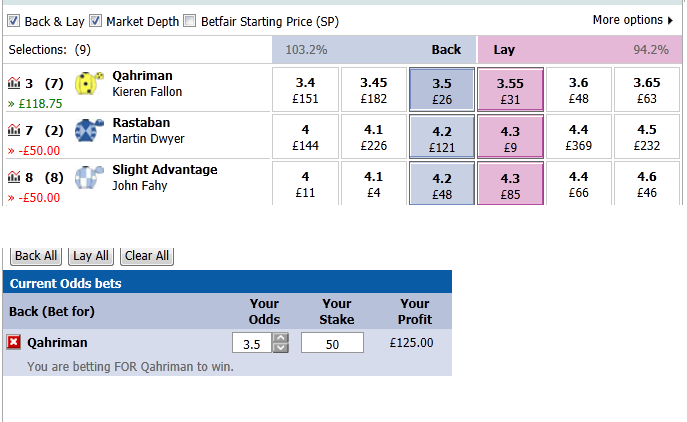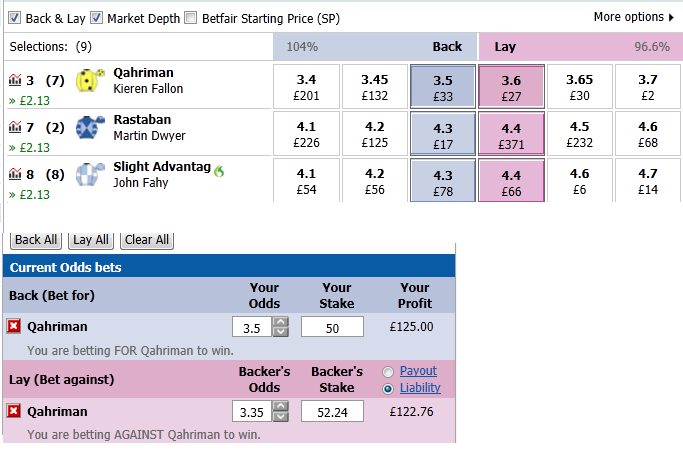Can You Really Make Risk Free Profits Trading On Horseraces?
September 26, 2011 by Jonathan
Filed under Betfair Tutorials, Horse Racing, Recent Articles
Exchange trading, scalping and greening up – are all terms used to describe the process of creating risk free bets using the betting exchanges. In this series of articles we’ll look at the various aspects of trading on horse races. Starting by defining the basics, then as the series progresses we`ll be covering intermediate to more advanced techniques, including the use of betting software.
Part 1.
Trading
Lots of eyes will immediately light up at the thought of buying low and selling high to make good profits. However, many are put off by currency trading because a large chunk of capital is often required by the broker. And depositing several thousand of one’s hard-earned into the hands of an anonymous someone on the other side of the world, in an industry that seems to have little oversight, is not appealing to those that think.
Share trading has its adherents, willing to pay the frequent commissions and deal with all the paperwork.
The appeal of sports trading is that anyone can start with only small amounts deposited with an online bookmaker and a betting exchange.
Commissions are generally reasonable, and a transaction history arrives with a mouse-click.
In this series of articles we will focus on trading horse races.
Trading Defined
For our purposes we will define trading as:
Betting to win (backing) and also betting to lose (laying) the same horse in the race, so as to lock in a guaranteed profit — regardless of whether that horse wins or loses.
The aim is always to back high and lay low.
An Example using Betfair:
You think the price of a favourite trading at 3.50 is going to shorten, so you back it for £50, this is the first step of the trade. However at this point you are simply placing straight bet to win £118.75 or lose £50 depending on the race outcome. Ultimately your money is exposed.
To complete the trade you need to place a lay bet at lower odds, offsetting your stake money to guarantee a green screen. In this example the trade is set to close out at 3.35 for £52.24, which guarantees a profit of £2.13 on every selection.
So you make a profit regardless of the outcome. (Minus the small betting exchange commission )
The Risk Factor
The thinkers will immediately put their finger on the risk factor: “After you’ve backed the horse for 50 units, then what happens if the lay odds start to increase? “
The answer is you always operate with a Stop Loss to minimize your loss. You decide beforehand the point at which you will place a lay bet so as to minimize your liability. Remember – when you bet a horse to lose you’ve got to pay those that opposed you if it wins. As a rule of thumb its good practice to set your stop loss to no more than twice your profit margin
Basic Strategies
Horse Race Traders (HRTs) have two basic, operating strategies available.
Option1: In the last few minutes before a race begins, they can repeatedly back and lay a horse to exploit to the back/lay price fluctuations.
Option 2: Or they can back a horse some time before the race begins, monitor the price fluctuations , and lay a horse at a suitable lower price (or set a Stop Loss in case the price rises)
For Option 1, you’ve got to be physically and psychologically suited to the stress of very fast-moving figures, and to your share of losing trades. You won’t win them all!
This is because on-the-fly traders work with races that have very high volatility.
To exploit the back and lay pieces so as to repeatedly lock-in mini profits there must be big chunks of money coming into the market to drive prices up and down.
The profits are in exploiting the fluctuations.
Personal Attributes
They need certain attributes:
- Perfect hand-eye co-ordination (fast clicking in response to what you see)
- Very fast reflexes
- Perfect close eyesight
- Unbreakable concentration
- An environment totally free of distractions (no visitors, phone calls or loud noises)
- Reliable power and reliable internet connection
- Fast internet connection (you’ll lose money if the connection or power keeps breaking)
- Able to process several tasks at once (multi-tasking skills are vital)
- Fast processing and understanding of numerical data (mental acuity)
- Very self-disciplined and emotionally controlled (remain stable whether winning or losing)
Option 2 is far more laid-back and much easier on the nervous system!
It gives you time to think, to plan and to enjoy the roses in between bets. You can operate in much less volatile markets.
Lightening fast reflexes and exceptional ability to read the racing markets are needed to perform manual tick trading, minutes before the start of a race (Option 1). Therefore this style of trading should only be undertaken by punters with plenty of Experience, even then we strongly recommend using betting software to eliminate errors, and provide you with the fastest bet placement options.
Achieving a green book
Future Articles
In future articles we’ll take a closer look at:
- trading software
- manual trading
- automatic trading with bots
We’ll review some of the products available. And cover one or two other relevant topics.
Further reading
Understanding the Betfair market graph on a horserace
Using your bet fair account more efficiently
Learn how to make realistic profits from betting
Practical, profitable advise direct to your inbox
- Proven techniques I use in my own betting
- Honest reviews on systems and services that are profitable
- Exclusive tips to make your betting easier & more profitable
 Copyright secured by Digiprove � 2010 Jonathan Burgess
Copyright secured by Digiprove � 2010 Jonathan Burgess










